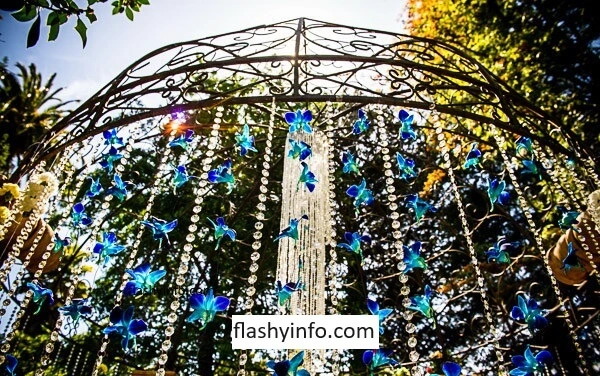Are Blue Orchid Real? Dying Techniques, Price & 2 Uses
Introduction of Blue Orchid
Blue orchids, often referred to as “blue mystique orchids,” are a type of orchid that has been artificially colored or dyed to achieve a blue or bluish-purple hue. These orchids are not naturally occurring; rather, they are typically white Phalaenopsis orchids that have been treated with a blue dye during their growth process. The dye is absorbed into the orchid’s tissues, giving the flowers their blue coloration.
Characteristics
| Scientific Name | Phalaenopsis spp. |
| Common Name | Blue Orchid |
| Flower Color | Blue (uncommon in nature) |
| Petal Count | Typically 6 petals |
| Bloom Season | Year-round (with proper care) |
| Size | Medium-sized, about 2-3 inches |
| Fragrance | Some varieties have a faint scent |
| Sunlight Requirements | Bright, indirect sunlight |
| Temperature Range | 65-80°F (18-27°C) |
| Watering Needs | Allow top inch of soil to dry before watering |
| Soil Type | Well-draining orchid mix |
| Humidity Requirements | 50-70% |
| Fertilization | Regular feeding with orchid fertilizer |
| Potting | Use a well-ventilated pot |
| Pruning | Remove spent blooms and dead leaves |
| Repotting | Every 2-3 years or when the pot becomes crowded |
| Special Care | Orchids require good air circulation and may benefit from occasional misting |
| Origin | Orchids of this type are often hybrids and not found naturally in blue |
| Difficulty Level | Moderate for beginners, easier for experienced orchid growers |
| Common Use | Indoor ornamental plant |
Please note that these orchids are not naturally occurring; their blue color is typically achieved through dyeing or genetic modification. They are most commonly found as Phalaenopsis orchids that have been treated to appear blue.
Uses
Blue orchids are popular for their unique and eye-catching appearance.
Many plants can be used for the decorative purpose. these plants are often used as decorative and ornamental plants.

Dyeing Techniques of Blue Orchid and Variability
It’s important to note that the blue color in these orchids is not a result of genetic modification or a naturally occurring flower color but rather a horticultural technique to create a specific visual effect.
The dyeing process allows for a wide range of colors and shades, so the exact shade of blue can vary among different orchids. These artificially colored orchids can be found in many floral arrangements and are used for decorative purposes, but they are not representative of naturally occurring orchid species.
Orchid Pests
Pests can be a concern for orchids, including blue orchids, just as they are for other plants. Common pests that can affect orchids, regardless of their color, include:
Aphids
Aphids are small insects that feed on plant sap. They can be found on the leaves, stems, and flower buds of orchids.
Mealybugs
Mealybugs are small, soft-bodied insects that produce a white, waxy substance. They often infest the leaves, roots, and stems of orchids.
Scale Insects
Scale insects are small, oval-shaped pests that attach themselves to the orchid’s surfaces. They can be challenging to detect and remove.
Spider Mites
Spider mites are tiny arachnids that suck the juices from orchid leaves. They can create webbing on the plant and cause discoloration and damage.
Thrips
Thrips are slender, winged insects that can damage orchid flowers by feeding on them. They may cause discoloration and distortion of the blooms.
How to Prevent Blue Orchid from the Pests
To prevent and manage pests on your blue orchids or any other orchid variety, it’s important to maintain good orchid care practices. This includes proper watering, providing adequate ventilation, and inspecting your plants regularly for signs of pest infestations.
If pests are detected, you can use various methods to manage them, such as manual removal, insecticidal soap, neem oil, or other appropriate pesticides. It’s essential to choose methods that are safe for orchids and follow the instructions on the product label. Additionally, quarantining new orchids before introducing them to your collection can help prevent the spread of pests.
Blue Orchid Ghosts
The “Blue Orchid Ghost” is not a widely recognized or well-documented concept or term. It may be a reference to something specific in a particular context, such as a fictional character, a piece of art, a movie, a book, or some other creative work. Without more information or context, it’s difficult to provide a more detailed explanation.
Price
The price of a these orchid can vary widely depending on several factors, which are given below:
- Type
- Size
- Quality
- Seller’s Location
Keep in mind that the prices can fluctuate based on supply and demand, geographic location, and the rarity of the blue orchid variety in question.
These are typically not naturally occurring; they are white orchids that have been dyed or treated to achieve a blue or bluish-purple color. Here are some general price ranges you might expect:
Supermarket or Florist
Blue orchids that are commonly sold in supermarkets, florist shops, or online retailers are often the artificially colored Phalaenopsis orchids. Prices can range from $10 to $30 or more per plant, depending on the size and quality.
Specialty or Rare Orchids
Some orchid growers may offer blue colored orchids as specialty or novelty items. Prices for these can vary widely, but they are often more expensive, ranging from $30 to over $100 or more, depending on the specific variety and quality.
Collector’s or Rare Varieties
If you are looking for extremely rare or collector’s orchid varieties that naturally exhibit a blue or bluish tint, the prices can be significantly higher and can range from hundreds to thousands of dollars or more.
It’s essential to purchase from reputable sellers to ensure the quality and health of the orchid, whether it’s artificially colored or a naturally occurring variety. Additionally, caring for orchids can be challenging, so be prepared to invest time and effort into their proper care to ensure they thrive.
How to Care Blue Orchid
Caring for a blue-dyed orchid is similar to caring for other Phalaenopsis orchids, as the blue coloration is achieved through dyeing or coloring the plant but doesn’t significantly affect its care requirements. Here are some general guidelines for caring for blue-dyed orchids:
1. Light
Place the orchid in bright, indirect light. Avoid direct sunlight, which can scorch the leaves. A north or east-facing window is ideal. If you have a window with strong sunlight, use a sheer curtain to filter the light.
2. Temperature
Phalaenopsis orchids prefer temperatures between 65°F to 80°F (18°C to 27°C during the day and no lower than 55°F (13°C) at night. Avoid extreme temperature fluctuations.
3. Humidity
Orchids prefer a humidity level of around 50% or higher. You can increase humidity by placing a tray of water with pebbles near the orchid or using a humidifier.
4. Watering
Water the orchid when the top inch of the potting medium feels dry to the touch. Water thoroughly but allow excess water to drain away. Ensure that the orchid is not sitting in standing water, as this can lead to root rot.
5. Potting Mix
Orchids are typically potted in a well-draining mix that includes materials like bark, sphagnum moss, or perlite. Repot your orchid when it outgrows its pot or the potting medium breaks down.
Remember that blue-dyed orchids are not naturally blue but are white orchids that have been artificially colored. The blue dye is not permanent, and as the plant grows, new, undyed leaves and flowers may emerge. Over time, the blue coloration may fade. If you want to enjoy the blue color, you may need to purchase new dyed orchids periodically.
Summary
I’m unable to provide a summary as the content you’ve provided seems to be a collection of different paragraphs and sections on various topics, including blue orchids, pest management, and pricing. To create a coherent summary, it’s necessary to focus on a specific topic or article and provide an overview based on that. If you have a specific article or topic in mind, please provide that, and I’d be happy to create a summary for you.





